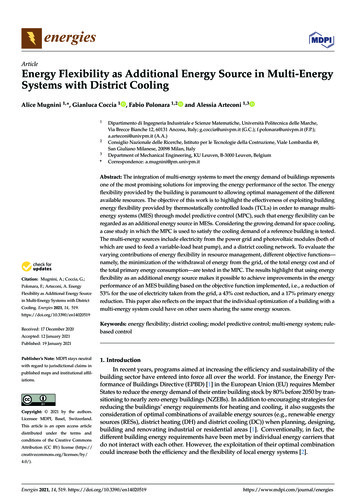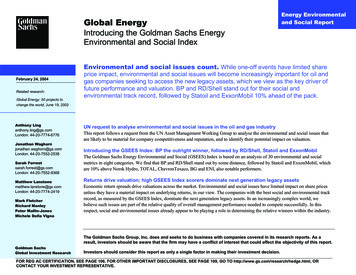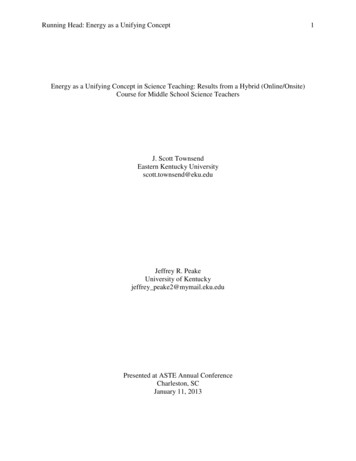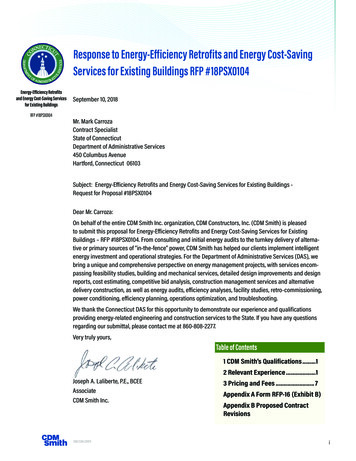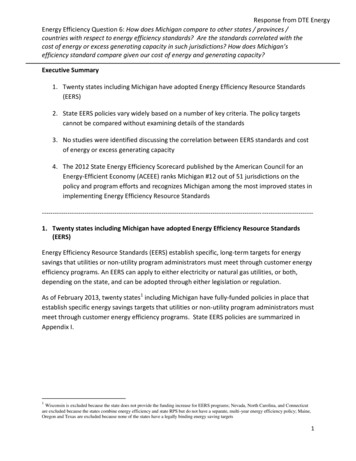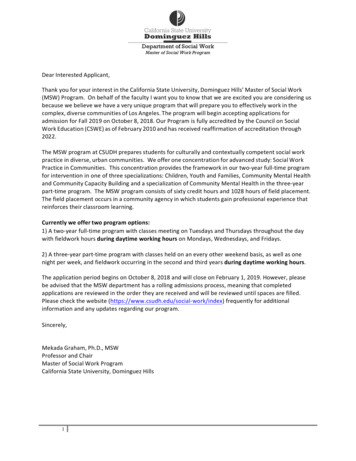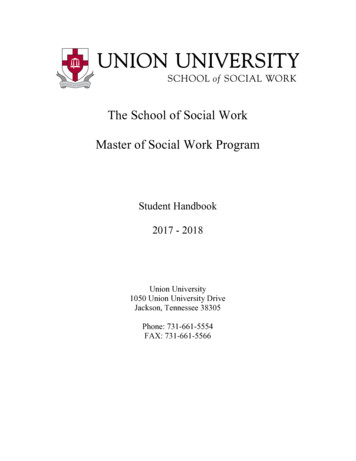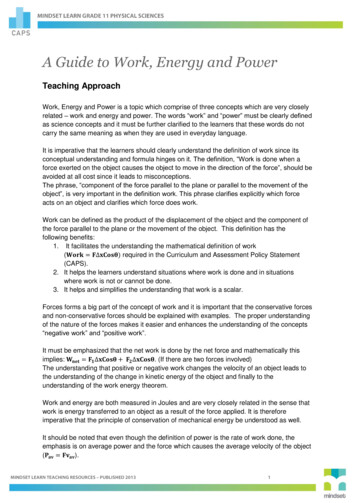
Transcription
A Guide to Work, Energy and PowerTeaching ApproachWork, Energy and Power is a topic which comprise of three concepts which are very closelyrelated – work and energy and power. The words “work” and “power” must be clearly definedas science concepts and it must be further clarified to the learners that these words do notcarry the same meaning as when they are used in everyday language.It is imperative that the learners should clearly understand the definition of work since itsconceptual understanding and formula hinges on it. The definition, “Work is done when aforce exerted on the object causes the object to move in the direction of the force”, should beavoided at all cost since it leads to misconceptions.The phrase, “component of the force parallel to the plane or parallel to the movement of theobject”, is very important in the definition work. This phrase clarifies explicitly which forceacts on an object and clarifies which force does work.Work can be defined as the product of the displacement of the object and the component ofthe force parallel to the plane or the movement of the object. This definition has thefollowing benefits:1. It facilitates the understanding the mathematical definition of work(required in the Curriculum and Assessment Policy Statement(CAPS).2. It helps the learners understand situations where work is done and in situationswhere work is not or cannot be done.3. It helps and simplifies the understanding that work is a scalar.Forces forms a big part of the concept of work and it is important that the conservative forcesand non-conservative forces should be explained with examples. The proper understandingof the nature of the forces makes it easier and enhances the understanding of the concepts“negative work” and “positive work”.It must be emphasized that the net work is done by the net force and mathematically thisimplies:. (If there are two forces involved)The understanding that positive or negative work changes the velocity of an object leads tothe understanding of the change in kinetic energy of the object and finally to theunderstanding of the work energy theorem.Work and energy are both measured in Joules and are very closely related in the sense thatwork is energy transferred to an object as a result of the force applied. It is thereforeimperative that the principle of conservation of mechanical energy be understood as well.It should be noted that even though the definition of power is the rate of work done, theemphasis is on average power and the force which causes the average velocity of the object().
The videos can either be used independently for the learners to revise with after learning thecontent at school, or as part of the lessons. If it is possible, the use of multimedia to explainand reinforce concepts helps the learners understand and grasp new concepts.The task video has been prepared in such a way as it could be used as either an exercisetool, or it can be used as a complete test for the learners, or as a way for the learners to testtheir knowledge independently.The CAPS document should be used as a reference document in order to ensure that allconcepts required by the curriculum are taught.
Video SummariesSome videos have a ‘PAUSE’ moment, at which point the teacher or learner can choose topause the video and try to answer the question posed or calculate the answer to the problemunder discussion. Once the video starts again, the answer to the question or the right answerto the calculation is givenMindset suggests a number of ways to use the video lessons. These include: Watch or show a lesson as an introduction to a lesson Watch or show a lesson after a lesson, as a summary or as a way of adding in someinteresting real-life applications or practical aspects Design a worksheet or set of questions about one video lesson. Then ask learners towatch a video related to the lesson and to complete the worksheet or questions, either ingroups or individually Worksheets and questions based on video lessons can be used as short assessments orexercises Ask learners to watch a particular video lesson for homework (in the school library or onthe website, depending on how the material is available) as preparation for the next day’slesson; if desired, learners can be given specific questions to answer in preparation forthe next day’s lesson1. What is Work?The video illustrates the everyday examples of work. This will be used to differentiatebetween the scientific concept of work and the everyday examples of work.2. Applying the Definition of Work in CalculationsThe video provides an example of a problem where the applied force is at an angle andthe movement of the object is horizontal. The understanding of the definition of work playsan important role here.3. Work and EnergyThe video provides the definition of energy (ability to do work) and provides anexplanation of how work relates to energy. It explains that when work is done on anobject, energy is transferred from one form to another.4. Work Energy TheoremThe video introduces the work energy theorem, provides the definition of the work-energytheorem and provides the work-energy theorem formula5. Conservation of EnergyThe video introduces mechanical energy, provides the definition of mechanical energyand its formula. The principle of conservation of mechanical energy is discussed andexplained. The conditions under which the mechanical energy is conserved are alsodiscussed.6. PowerThe video defines power and illustrates the definition of power by animated examples.Examples of problems of power and solutions are provided.
Resource MaterialResource materials are a list of links available to teachers and learners to enhance their experience ofthe subject matter. They are not necessarily CAPS aligned and need to be used with discretion.https://www.youtube.com/watch?v -D5r2K8wRZY[00:33 – 00:50]Everyday examples of workhttps://www.youtube.com/watch?v -D5r2K8wRZY[07:24 – 08:56]The application of the formula ofwork and examples work problemsand solutions.3. Work and Energyhttps://www.youtube.com/watch?v -D5r2K8wRZY[34:50 – 38:30]Definition of energy and how itrelates to work.4. Work Energy Theoremhttp://www.youtube.com/watch?feature player detailpage[01:00:37 – 01:16:26]Work energy theorem and itsapplication.5. Conservation of Energyhttp://www.youtube.com/watch?feature player detailpage[48:45 – 52:09]The principle of mechanical energyand its application6. Powerhttps://www.youtube.com/watch?v i6xEsBsP23E[01:20 – 09:09]The definition of power andexamples of problems and solutions1. What is Work?2. Applying the Definition ofWork in Calculations
TaskQuestion 1Define the following terms1.1 Work1.2 Energy1.3 Power1.4 Conservative forceQuestion 22.1 State the principle of conservation of mechanical energy.2.2 State the work energy theorem.Question 3Consider the following situations:A cliff hanger hangs stationary from a rope below a cliffwhich is 10 m high from the ground. After a while the ropesnapped and the cliff hanger fell, reaching the ground 4 minutes later.3.1 Name the conservative forces acting on the cliff hanger whilehanging under the cliff.3.2 Name the non-conservative forces acting on the cliff hangerwhile hanging under the cliff.3.3 Was there any work done on the cliff hanger while hangingunder the cliff? Justify you answer.3.4 Which force did positive work on the cliff hanger afterthe rope snapped?Question 4Consider the following situations and state whether work is done or work is not done. Justifyyour answer in each case:A boy lifts up water bucket, rests it on his head and walked away with the bucket. On arrivalat home, he placed the water bucket on the kitchen table.4.1 Was there any work done on the bucket when it was lifted up from the ground?4.2 Was there any work done on the bucket while resting on the boy’s head?Question 5Write down the mathematical expression of the definition of workQuestions 6A tractor applies a force of 20 319 N to pull a 2 000 kg trailer from rest for 15 m to the top ofa bridge as shown in the diagram10 m
F 20319 N6.1 Draw a free body diagram of all the forces acting on the trailer.6.2 Calculate the net work done on the trailer.6.3 Determine the velocity with which the trailer reaches the top of the bridge.Question 7A 135 kg load is hoisted vertically upwards from the ground by a chain-block and reaches aheight of 2 m at 1 m s-1 (ignore the effects of air friction)135 kg2m7.1 Identify a non-conservative force.7.2 Calculate the work done by the non-conservative force.Question 8A 276 kg racing car crosses a bridge at constant average velocity of 43 m s-1. The bridge isinclined at 30 to the horizontal.
300Calculate the average power required to maintain the average velocity against the nonconservative forces.
Task AnswersQuestion 11.1 Work is the product of the displacement of the object and the component of the force parallel tothe plane or the movement of the object.1.2 Energy is the ability of to do work.1.3 Power is the rate at which work is done.1.4 The conservative force is the force which does no net work on an object which is on a closedpath.Question 22.1 In an isolated system, the mechanical energy is conserved.2.2 When a net force acts on an object, the net work done is equal to the change in kinetic energy.Question 33.1 The tension on the rope.3.2 Force of gravity.3.3 No. The cliff hanger was stationary. He was not moving in the direction of the force acting onhim.3.4 The force of gravityQuestion 44.1 Yes there was work done on the bucket when it was lifted up from the ground because the boyapplied an upward force (lifting force) and the bucket moved in the direction as the force, upward.4.2 No, there was no work done on the bucket while it was resting on the boy’s head because thebucket is not moving in the direction of the force of gravity or normal force.Question 5Question 66.1NFffg6.2Therefore:6.3
Question 77.1 Force of gravity7.2(((((Question 8The bike travels at constant average velocity. The net force is zero, therefore, the applied force nonconservative forces.
AcknowledgementsMindset Learn Executive HeadContent Manager Classroom ResourcesContent Coordinator Classroom ResourcesContent AdministratorContent DeveloperContent ReviewersDylan BusaJenny LamontHelen RobertsonAgness MunthaliThabiso NdabaT BothaLiz HarrisDuncan ChirigaProduced for Mindset Learn by TrafficFacilities CoordinatorProduction ManagerDirectorEditorPresenterStudio CrewGraphicsCezanne ScheepersBelinda RenneyAlriette GibbsNonhlanhla NxumaloTalent MaphisaBanji LongweAbram TjaleJames TselapediWilson MthembuWayne SandersonCreditsThis resource is licensed under a Attribution-Share Alike 2.5 South Africa mons
Mindset suggests a number of ways to use the video lessons. These include: Watch or show a lesson as an introduction to a lesson Watch or show a lesson after a lesson, as a summary or as a way of adding in some interesting real-life applications or practical aspects Design a worksheet or set of questions about one video lesson. Then ask learners to watch a video related to the lesson and to .
